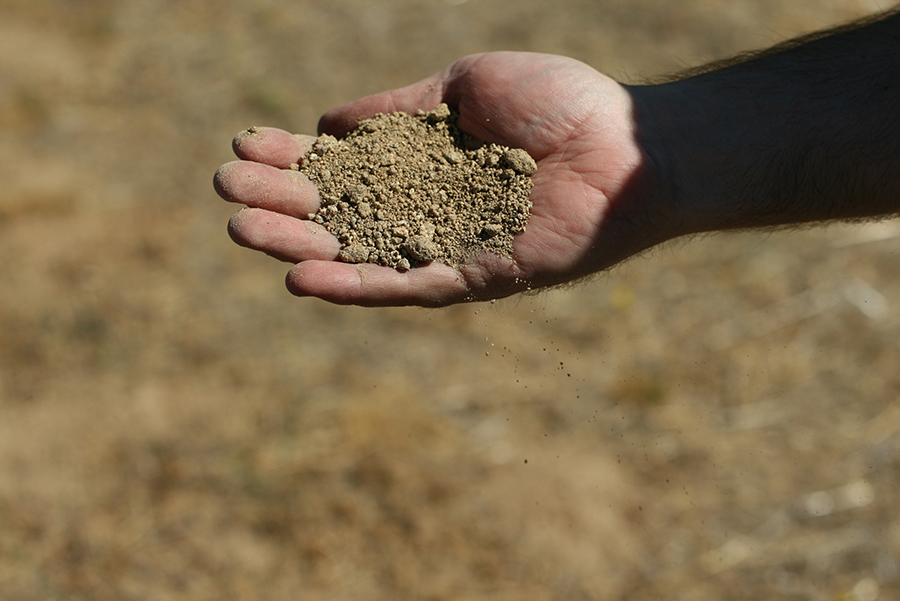With the new year now underway and CompostCon, the celebration of compost, occurring on January 25, I thought I would spice up this installment of Everyday Soil Science with a tasty controversy.
There’s a great debate among self-proclaimed “foodies” about the significance of microclimates, geography, water, and, of course, soil on the flavors we associate with wines, cheeses, breads, meats, poultry, garden vegetables, and just about everything we eat that hasn’t been processed.
I’m talking of course about terroir. Terroir (tair-WAHR) is the French term for soil often used in conjunction with the phrase gout de terroir or, taste of the soil. The term is particularly beloved among wine lovers. If you’ve seen Dirt! The Movie, you’ll undoubtedly recall the scene in which a well-regarded wine expert compares the flavor of the Sangiovese he just chugged to a pinch of the vineyard sandy loam swirling in his mouth. That’s commitment. And, yes, I’ve done it! (Though I don’t recommend making a habit of tasting soil.)
I happen to be among those who believe that “living” soil, filled with microbes, does impart unique flavor characteristics (among other benefits) to the unadulterated food that we grow and eat. The body of scientific knowledge on the mechanisms of terroir is less than copious, and some of it quite frankly borders on non-sense, but recent research conducted at the University of California, Davis (Go Aggies!) and published in the Proceedings of the National Academy of Sciences has unearthed a correlation between microbes and terroir.
 Without getting into the nitty gritty details of the study, the Davis scientists found that California white wine grapes of the same cultivar, or grown in the same region were inoculated with a related suite of bacteria and fungi in spite of the diversity of microbial communities found throughout the state. Where terroir was once thought to be associated with purely environmental factors like weather, elevation, and soil mineralogy – microbial biology now enters the picture as a factor that integrates all of the previous elements of terroir.
Without getting into the nitty gritty details of the study, the Davis scientists found that California white wine grapes of the same cultivar, or grown in the same region were inoculated with a related suite of bacteria and fungi in spite of the diversity of microbial communities found throughout the state. Where terroir was once thought to be associated with purely environmental factors like weather, elevation, and soil mineralogy – microbial biology now enters the picture as a factor that integrates all of the previous elements of terroir.
As you’ll undoubtedly remember from previous installments of Everyday Soil Science – microbes are the key to living soil. That microbes, or the byproducts that they produce, can actually influence the flavor or what we eat and drink makes perfect sense to me. What makes a loaf of sourdough bread made in San Francisco different from a loaf made in Boston? It’s the microbes in the starter. San Francisco sourdough tastes the way it does due to the microbes that are native to the Bay Area. The same line of thinking can be applied to cheese produced in Point Reyes or Monterey. What ultimately gives flavor to much of what we eat is associated with the microbes that have inoculated it.
So what’s the bottom line? Keep your soil alive and thriving with organic matter (compost, compost, compost), and your neighborhood microbes will kick up the gout de terroir in everything you grow and eat. You can try this simply enough by growing your own organic carrots and comparing them to organic carrots sold at your favorite grocery. I informally had a group of my Berkeley students do this one summer for fun and the results, though anecdotal, were quite compelling. In repeated blind tasting the students consistently selected the homegrown organic carrots as having both better taste (as defined by richness and uniqueness of flavor), and more taste (as defined by intensity and duration of flavor on the palate) than the grocery counterparts. True, it wasn’t a scientific study, nevertheless the consistency of the results begs the question about the role of microbes and terroir.
Eat, drink, and celebrate gout de terroir!
~The Soil Sommelier
For more information about terroir, visit the following sites:
Livermore Valley Winegrowers Association – Terroir & Appellation
Wineanorak.com – Mechanisms of terroir: How soils affect the taste of wine
Organic Trade Association – Nutritional Considerations
Photos courtesy of Block122.com



